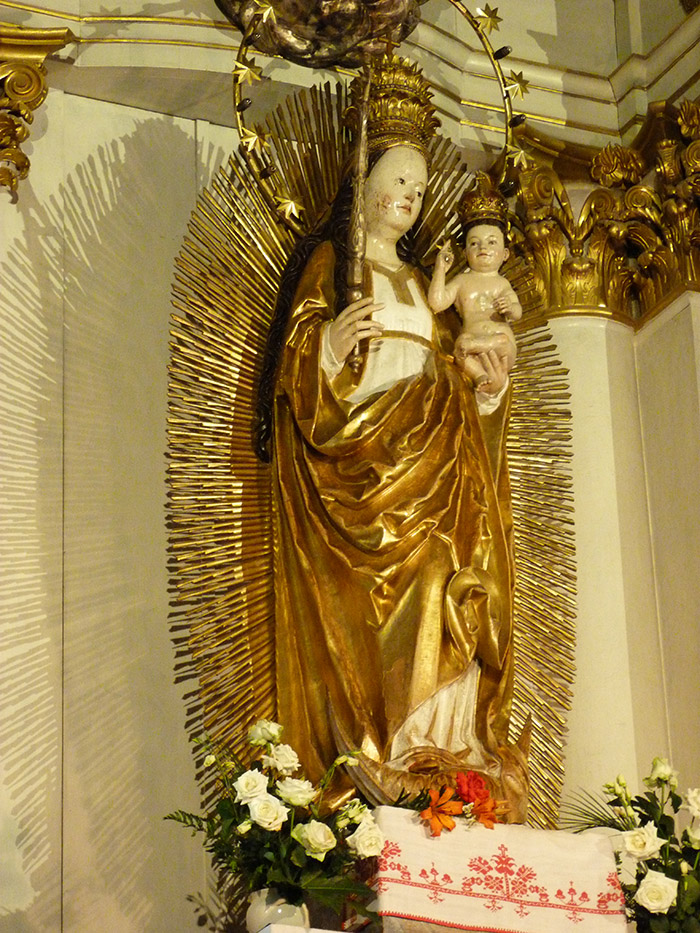Legend has it that when Turkish and Tatar troops broke into Transylvania in 1661 – one of many such incursions – a Tatar unit raided the Franciscan church in the small village of Csíksomlyó (Şumuleu Ciuc). The Tatar commanding officer, according to the legend, having recognized the value of a devotional statue of the Virgin Mary, ordered his troops to take it with them. But the statue resisted: it became so heavy that even eight pairs of oxen couldn’t make it budge.
The officer then unsheathed his sword and went on to hit the statue several times in blind rage – the wounds are still said to be visible.
The government of modern Romania seems to display the same irrational fear of Catholic pilgrims. At least we cannot think of any rational explanation for them opposing the admission of the Pentecost pilgrimage of Csíksomlyó in the UNESCO List of Intangible Cultural Heritage back in 2016.

The Pentecost Pilgrimage of Csíksomlyó is the largest religious and ritual event of Catholics in the Carpathian Basin, an event in the area around the Franciscan monastic settlement of Somlyó that has been reference in ecclesiastic documents and oral tradition going back to 1442.
The central element of the pilgrimage is the veneration of the Virgin Mary. Hundreds of thousands of participants express their gratitude with donations and commemorative plates, showing their devotion through prayers and religious folk practices.
Catholic pilgrims come from Transylvania and Moldova, from rural and urban settlements of Romania, Hungary, Slovakia, Germany, Brazil and Australia – just to name some of them.
In 2011, Romanian Minister of Culture Hunor Kelemen and his team initiated a procedure to include the pilgrimage in the Representative List of the Intangible Cultural Heritage of Humanity.
The nomination file was carefully compiled with the cooperation of professional organizations, the Franciscan order, local cultural institutions, all levels of municipal and state authorities, researchers, heritage specialists and national museums. It included a thorough description of the site and its religious significance, plans for safeguarding the site’s cultural and religious values as well as for activities to promote the site and raise awareness of its significance.
Representatives of the Roman Catholic community, the local administration authorities, cultural institutions, non-governmental organizations and professional associations backed the nomination of the Pilgrimage of Csíksomlyó to be included on the Representative List of Intangible Cultural Heritage.
In 2012, the nomination file was submitted to UNESCO. Around the same time, Romanian authorities began to display cold feet. They simply did not reply to UNESCO’s questions about the application — a standard part of the procedure — thus, the file was not evaluated further.
But the team involved in the original bid refused to give up. In 2014, when Kelemen was again appointed Minister of Culture, the file was re-submitted with the clarifications requested by UNESCO. The file was evaluated by UNESCO and submitted for final approval to the Intergovernmental Committee for the Safeguarding of Intangible Cultural Heritage. The meeting of the Committee took place in Addis Ababa, Ethiopia, from November 28 to December 2, 2016.
At the meeting, the representative of the Romanian government, a state secretary from the Ministry of Culture did not support the inclusion of the Pilgrimage of Csiksomlyó in the UNESCO list. When asked to make a single verbal clarification he refused to do so, but later gave exhaustive answers during the debate about another file submitted by Romania. In fact, he asked UNESCO to return the Csíksomlyó file to Romania.
This unprecedented approach caused a major uproar both in the Hungarian community in Romania and throughout the world. It was a clear indication that the Romanian government, led at the time by Dacian Cioloș, had no respect at all for the cultural heritage of the Hungarian community from Transylvania. The Washington Post published an AP report about the discrimination against the largest Catholic pilgrimage in the region.
This is also the first time in Romanian history that a so-called technocrat government perceived Hungarian pilgrims and their devotion as a threat. Despite all this, hundreds of thousands of Catholic pilgrims go each year to Csíksomlyó to pray for the souls of everyone.
Neither the Turks, nor the Tatars, not even Ceausescu, Romania’s feared dictator, managed to overcome the Catholic pilgrims in their adoration of Virgin Mary. It reminds us that governments might come and go, but the Csíksomlyói Szűzanya (the Holy Mother of Şumuleu) will still stand there and shine peace and wisdom upon all those souls that pray to her.
Related: Pope Francis arrives in Romania for Apostolic Journey